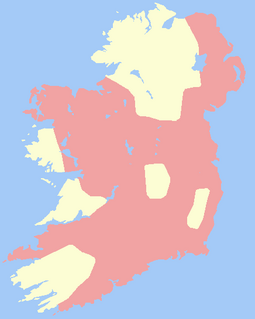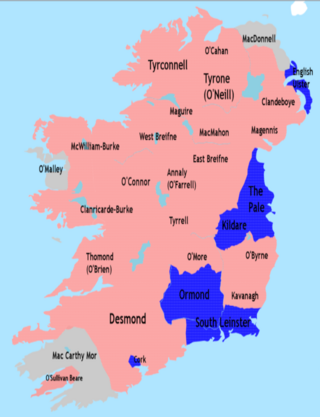 W
WThe Bruce campaign was a three-year military campaign in Ireland by Edward Bruce, brother of the Scottish king Robert the Bruce. It lasted from his landing at Larne in 1315 to his defeat and death in 1318 at the Battle of Faughart in County Louth. It was part of the First War of Scottish Independence and the conflict between the Irish and the Anglo-Normans.
 W
WThe Congo Crisis was a period of political upheaval and conflict in the Republic of the Congo between 1960 and 1965. The crisis began almost immediately after the Congo became independent from Belgium and ended, unofficially, with the entire country under the rule of Joseph-Désiré Mobutu. Constituting a series of civil wars, the Congo Crisis was also a proxy conflict in the Cold War, in which the Soviet Union and the United States supported opposing factions. Around 100,000 people are believed to have been killed during the crisis.
 W
WThe Cromwellian conquest of Ireland or Cromwellian war in Ireland (1649–1653) was the conquest of Ireland by the forces of the English Parliament, led by Oliver Cromwell, during the Wars of the Three Kingdoms. Cromwell invaded Ireland with his New Model Army on behalf of England's Rump Parliament in August 1649.
 W
WThe Desmond Rebellions occurred in 1569–1573 and 1579–1583 in the Irish province of Munster.
 W
WThe English Civil War (1642–1651) was a series of civil wars and political machinations between Parliamentarians ("Roundheads") and Royalists ("Cavaliers"), mainly over the manner of England's governance and issues of religious freedom. It was part of the wider Wars of the Three Kingdoms. The first (1642–1646) and second (1648–1649) wars pitted the supporters of King Charles I against the supporters of the Long Parliament, while the third (1649–1651) saw fighting between supporters of King Charles II and supporters of the Rump Parliament. The wars also involved the Scottish Covenanters and Irish Confederates. The war ended with Parliamentarian victory at the Battle of Worcester on 3 September 1651.
 W
WThe French expedition to Ireland, known in French as the Expédition d'Irlande, was an unsuccessful attempt by the First French Republic during the French Revolutionary Wars to assist the outlawed Society of United Irishmen, a popular rebel Irish republican group, in their planned rebellion against British rule. The French intended to land a large expeditionary force in Ireland during the winter of 1796–1797 which would join with the United Irishmen and drive the British out of Ireland. The French anticipated that this would be a major blow to British morale, prestige and military effectiveness, and was also intended to possibly be the first stage of an eventual invasion of Britain itself. To this end, the Directory gathered a force of approximately 15,000 soldiers at Brest under General Lazare Hoche during late 1796, in readiness for a major landing at Bantry Bay in December.
 W
WThe Expédition d'Irlande was a French attempt to invade Ireland in December 1796 during the French Revolutionary Wars. Encouraged by representatives of the Society of United Irishmen, an Irish republican organisation, the French Directory decided that the best strategy for eliminating Britain from the war was to invade Ireland, then under British control. It was hoped that a substantial invasion in the summer of 1796 would encourage a widespread uprising among the Irish population and force the British to abandon Ireland, providing a major strategic and propaganda coup for the French Republic and a staging point for a subsequent invasion of Britain. Assigned to lead the operation was General Lazare Hoche, the Republic's most successful military commander, who was provided with a significant body of troops and the services of the entire French Atlantic fleet.[A]
 W
WThe French Revolutionary Wars were a series of sweeping military conflicts lasting from 1792 until 1802 and resulting from the French Revolution. They pitted France against Great Britain, Holy Roman Empire, Prussia, Russia, and several other monarchies. They are divided in two periods: the War of the First Coalition (1792–97) and the War of the Second Coalition (1798–1802). Initially confined to Europe, the fighting gradually assumed a global dimension. After a decade of constant warfare and aggressive diplomacy, France had conquered a wide array of territories, from the Italian Peninsula and the Low Countries in Europe to the Louisiana Territory in North America. French success in these conflicts ensured the spread of revolutionary principles over much of Europe.
 W
WThe Irish Civil War was a conflict that followed the Irish War of Independence and accompanied the establishment of the Irish Free State, an entity independent from the United Kingdom but within the British Empire.
 W
WThe Irish Rebellion of 1798 was an uprising against British rule in Ireland. The United Irishmen, a republican revolutionary group influenced by the ideas of the American and French revolutions, were the main organising force behind the rebellion, led by Presbyterians angry at being shut out of power by the Anglican establishment and joined by Catholics, who made up the majority of the population. A French army which landed in County Mayo in support of the rebels was overwhelmed by British and loyalist forces. The uprising was suppressed by British Crown forces with a death toll of between 10,000 and 30,000.
 W
WThe Irish Republic of 1798, more commonly called the Republic of Connacht, was a short lived puppet state proclaimed during the Irish Rebellion of 1798 that resulted from the French Revolutionary Wars. In theory the republic was to cover the whole island of Ireland, but its functional control was limited to only very small parts of the Province of Connacht. The opposing Irish Royal Army was deployed across most of the country including the main towns such as Dublin, Belfast and Cork.
 W
WThe Irish War of Independence or Anglo-Irish War was a guerrilla war fought in Ireland from 1919 to 1921 between the Irish Republican Army and British forces: the British Army, along with the quasi-military Royal Irish Constabulary (RIC) and its paramilitary forces the Auxiliaries and Ulster Special Constabulary (USC). It was an escalation of the Irish revolutionary period into warfare.
 W
WThis article is a list of the participants, both civilian and military, of the Nine Years' War in Ireland. The war was fought in the late 16th and early 17th century and was a conflict between a coalition of Irish lords and their Spanish allies against the English and their authorities in Ireland.In order to be listed here an individual must have a historical record of their conduct, position or any role they played in the war during the years 1593-1603.
 W
WThe Mali War is an ongoing armed conflict that started in January 2012 between the northern and southern parts of Mali in Africa. On 16 January 2012, several insurgent groups began fighting a campaign against the Malian government for independence or greater autonomy for northern Mali, which they called Azawad. The National Movement for the Liberation of Azawad (MNLA), an organization fighting to make this area of Mali an independent homeland for the Tuareg people, had taken control of the region by April 2012.
 W
WThe military history of Ireland comprises thousands of years of armed actions in the territory encompassing the island of Ireland.
 W
WThe Nine Years' War, sometimes called Tyrone's Rebellion, took place in Ireland from 1593 to 1603. It was fought between an Irish alliance—led mainly by Hugh O'Neill of Tyrone and Hugh Roe O'Donnell of Tyrconnell—against English rule in Ireland, and was a response to the then-ongoing Tudor conquest of Ireland. The war was fought in all parts of the country, but mainly in the northern province of Ulster. The Irish alliance won some important early victories, such as the Battle of Clontibret (1595) and the Battle of the Yellow Ford (1598), but the English won a decisive victory against the alliance and their Spanish allies in the Siege of Kinsale (1601–02). The war ended with the Treaty of Mellifont (1603). Many of the defeated northern lords left Ireland to seek support for a new uprising in the Flight of the Earls (1607), never to return. This marked the end of Gaelic Ireland and led to the Plantation of Ulster.
 W
WThe Troubles was an ethno-nationalist conflict in Northern Ireland during the late 20th century. Also known internationally as the Northern Ireland conflict, it is sometimes described as an "irregular war" or "low-level war". The conflict began in the late 1960s and is usually deemed to have ended with the Good Friday Agreement of 1998. Although the Troubles primarily took place in Northern Ireland, at times the violence spilled over into parts of the Republic of Ireland, England, and mainland Europe.
 W
WThe Wars of the Three Kingdoms, sometimes known as the British Civil Wars, were an intertwined series of conflicts that took place between 1639 and 1653 in the kingdoms of England, Scotland and Ireland – separate kingdoms which had the same king, Charles I. The wars were fought mainly over issues of governance and religion, and included rebellions, civil wars and invasions. The English Civil War has become the best-known of these conflicts. It ended with the English parliamentarian army defeating all other belligerents, the execution of the king, the abolition of the monarchy, and the founding of the Commonwealth of England; a unitary republic which controlled the British Isles until 1660.
 W
WThe Williamite War in Ireland (1688–1691), was a conflict between Jacobite supporters of deposed monarch James II and Williamite supporters of his successor, William III. It is also called the Jacobite War in Ireland or the Williamite–Jacobite War in Ireland.
 W
WWorld War I was a global war originating in Europe that lasted from 28 July 1914 to 11 November 1918. Contemporaneously known as the Great War or "the war to end all wars", it led to the mobilisation of more than 70 million military personnel, including 60 million Europeans, making it one of the largest wars in history. It is also one of the deadliest conflicts in history, with an estimated nine million combatant deaths and 13 million civilian deaths as a direct result of the war, while resulting genocides and the related 1918 Spanish flu pandemic caused another 17–100 million deaths worldwide, including an estimated 2.64 million Spanish flu deaths in Europe and as many as 675,000 Spanish flu deaths in the United States.
 W
WDuring World War I (1914–1918), Ireland was part of the United Kingdom of Great Britain and Ireland, which entered the war in August 1914 as one of the Entente Powers, along with France and Russia. In part as an effect of chain ganging, the UK decided due to geopolitical power issues to declare war on the Central Powers, consisting of Germany, Austria-Hungary, the Ottoman Empire, and Bulgaria.